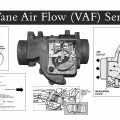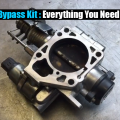An air conditioner compressor is the component in the system that
raises the temperature and pressure of the vapor refrigerant that leaves
the evaporator coil. Its important that the compressor raises the
pressure of the vapor refrigerant so that it creates a pressure
difference, the pressure difference is needed in order for the
refrigerant to flow. High pressure fluids flow towards lower pressure
fluid. Basically whats happening is the compressor is raising the
pressure of the refrigerant so that the refrigerant will flow to the
lower pressure refrigerant in the evaporator coil.
The compressor
raising the pressure will also increase the temperature. The direction
of heat transfer is from a higher temperature substance to a lower
temperature substance, the lower temperature being in the evaporator
coil and the hotter being in the compressor and condenser.
The temperature of the freon being increased is very important, because the refrigerant will get so hot that the hot air outside will be cooler even in the summer when it can be up to 120 degrees! The air being cooler outside allows the heat in the refrigerant to transfer to it when it goes through the condenser coils. The heat in the refrigerant was transferred originally from the heat inside the home at the evaporator coil. Its important that the compressor increase the temperature so that it can finish removing the heat from inside the home to the condenser.
Air conditioner and heat pump compressors are known as vapor compressors because they are not meant to have any liquid, and liquids are not a compressible fluid. Any liquid that may enter the compressor will result in reduced efficiency and capacity and will typically cause mechanical damage to the compressors internal components.
The main and important types of gas compressors are illustrated and discussed below:
#Gas-compressors-types
A positive displacement compressor is the system which compresses the
air by the displacement of a mechanical linkage reducing the volume
(since the reduction in volume due to a piston in thermodynamics is
considered as positive displacement of the piston).[vague]
#Reciprocating compressors
A motor-driven six-cylinder reciprocating compressor that can operate with two, four or six cylinders.
Reciprocating compressors use pistons driven by a crankshaft. They can
be either stationary or portable, can be single or multi-staged, and can
be driven by electric motors or internal combustion engines.[1][2][3]
Small reciprocating compressors from 5 to 30 horsepower (hp) are
commonly seen in automotive applications and are typically for
intermittent duty. Larger reciprocating compressors well over 1,000 hp
(750 kW) are commonly found in large industrial and petroleum
applications. Discharge pressures can range from low pressure to very
high pressure (>18000 psi or 180 MPa). In certain applications, such
as air compression, multi-stage double-acting compressors are said to be
the most efficient compressors available, and are typically larger, and
more costly than comparable rotary units.[4] Another type of
reciprocating compressor, usually employed in automotive cabin air
conditioning systems,[citation needed] is the swash plate or wobble
plate compressor, which uses pistons moved by a swash plate mounted on a
shaft (see axial piston pump).
Household, home workshop, and smaller job site compressors are typically reciprocating compressors 1½ hp or less with an attached receiver tank.
A linear compressor is a reciprocating compressor with the piston being the rotor of a linear motor.
#Ionic liquid piston compressor
Main article: Ionic liquid piston compressor
An ionic liquid piston compressor, ionic compressor or ionic liquid
piston pump is a hydrogen compressor based on an ionic liquid piston
instead of a metal piston as in a piston-metal diaphragm compressor.[5]
#Rotary screw compressors
Diagram of a rotary screw compressor
Main article: Rotary screw compressor
Rotary screw compressors use two meshed rotating positive-displacement
helical screws to force the gas into a smaller space.[1][6][7] These are
usually used for continuous operation in commercial and industrial
applications and may be either stationary or portable. Their application
can be from 3 horsepower (2.2 kW) to over 1,200 horsepower (890 kW) and
from low pressure to moderately high pressure (>1,200 psi or 8.3
MPa).
The classifications of rotary screw compressors vary based on stages, cooling methods, and drive types among others.[8] Rotary screw compressors are commercially produced in Oil Flooded, Water Flooded and Dry type. The efficiency of rotary compressors depends on the air drier,[clarification needed] and the selection of air drier is always 1.5 times volumetric delivery of the compressor.[9]
Designs with a single screw [10] or three screws [11] instead of two exist.
#Rotary vane compressors
Eccentric rotary-vane pump
See also: Rotary vane pump
Rotary vane compressors consist of a rotor with a number of blades
inserted in radial slots in the rotor. The rotor is mounted offset in a
larger housing that is either circular or a more complex shape. As the
rotor turns, blades slide in and out of the slots keeping contact with
the outer wall of the housing.[1] Thus, a series of increasing and
decreasing volumes is created by the rotating blades. Rotary Vane
compressors are, with piston compressors one of the oldest of compressor
technologies.
With suitable port connections, the devices may be either a compressor or a vacuum pump. They can be either stationary or portable, can be single or multi-staged, and can be driven by electric motors or internal combustion engines. Dry vane machines are used at relatively low pressures (e.g., 2 bar or 200 kPa or 29 psi) for bulk material movement while oil-injected machines have the necessary volumetric efficiency to achieve pressures up to about 13 bar (1,300 kPa; 190 psi) in a single stage. A rotary vane compressor is well suited to electric motor drive and is significantly quieter in operation than the equivalent piston compressor.
Rotary vane compressors can have mechanical efficiencies of about 90%.[12]
#Rolling piston
Rolling piston compressor
The Rolling piston in a rolling piston style compressor plays the part
of a partition between the vane and the rotor.[13] Rolling piston forces
gas against a stationary vane.
2 of these compressors can be mounted on the same shaft to increase capacity and reduce vibration and noise. A design without a spring is known as a swing compressor.
In refrigeration and air conditioning, this type of compressor is also known as a rotary compressor, with rotary screw compressors being also known simply as screw compressors.
#Scroll compressors
Mechanism of a scroll pump
Main article: Scroll compressor
A scroll compressor, also known as scroll pump and scroll vacuum pump,
uses two interleaved spiral-like vanes to pump or compress fluids such
as liquids and gases. The vane geometry may be involute, archimedean
spiral, or hybrid curves.[14][15][16] They operate more smoothly,
quietly, and reliably than other types of compressors in the lower
volume range.
Often, one of the scrolls is fixed, while the other orbits eccentrically without rotating, thereby trapping and pumping or compressing pockets of fluid between the scrolls.
Due to minimum clearance volume between the fixed scroll and the orbiting scroll, these compressors have a very high volumetric efficiency.
These compressors are extensively used in air conditioning and refrigeration because they are lighter, smaller and have fewer moving parts than reciprocating compressors and they are also more reliable. They are more expensive though, so peltier coolers or rotary and reciprocating compressors may be used in applications where cost is the most important or one of the most important factors to consider when designing a refrigeration or air conditioining system.
This type of compressor was used as the supercharger on Volkswagen G60 and G40 engines in the early 1990s.
#Diaphragm compressors
Main article: Diaphragm compressor
A diaphragm compressor (also known as a membrane compressor) is a
variant of the conventional reciprocating compressor. The compression of
gas occurs by the movement of a flexible membrane, instead of an intake
element. The back and forth movement of the membrane is driven by a rod
and a crankshaft mechanism. Only the membrane and the compressor box
come in contact with the gas being compressed.[1]
The degree of flexing and the material constituting the diaphragm affects the maintenance life of the equipment. Generally stiff metal diaphragms may only displace a few cubic centimeters of volume because the metal can not endure large degrees of flexing without cracking, but the stiffness of a metal diaphragm allows it to pump at high pressures. Rubber or silicone diaphragms are capable of enduring deep pumping strokes of very high flexion, but their low strength limits their use to low-pressure applications, and they need to be replaced as plastic embrittlement occurs.
Diaphragm compressors are used for hydrogen and compressed natural gas (CNG) as well as in a number of other applications.
#A three-stage diaphragm compressor
The photograph on the right depicts a three-stage diaphragm compressor
used to compress hydrogen gas to 6,000 psi (41 MPa) for use in a
prototype compressed hydrogen and compressed natural gas (CNG) fueling
station built in downtown Phoenix, Arizona by the Arizona Public Service
company (an electric utilities company). Reciprocating compressors were
used to compress the natural gas. The reciprocating natural gas
compressor was developed by Sertco.
The prototype alternative fueling station was built in compliance with all of the prevailing safety, environmental and building codes in Phoenix to demonstrate that such fueling stations could be built in urban areas.
Dynamic compressors depend upon the inertia and momentum of a fluid.
#Air bubble compressor
Also known as a trompe. A mixture of air and water generated through turbulence is allowed to fall into a subterranean chamber where the air separates from the water. The weight of falling water compresses the air in the top of the chamber. A submerged outlet from the chamber allows water to flow to the surface at a lower height than the intake. An outlet in the roof of the chamber supplies the compressed air to the surface. A facility on this principle was built on the Montreal River at Ragged Shutes near Cobalt, Ontario in 1910 and supplied 5,000 horsepower to nearby mines.[18]
#Centrifugal compressors
A single stage centrifugal compressor
Main article: Centrifugal compressor
Centrifugal compressors use a rotating disk or impeller in a shaped
housing to force the gas to the rim of the impeller, increasing the
velocity of the gas. A diffuser (divergent duct) section converts the
velocity energy to pressure energy. They are primarily used for
continuous, stationary service in industries such as oil refineries,
chemical and petrochemical plants and natural gas processing
plants.[1][19][20] Their application can be from 100 horsepower (75 kW)
to thousands of horsepower. With multiple staging, they can achieve high
output pressures greater than 1,000 psi (6.9 MPa).
This type of compressor, along with screw compressors, are extensively used in large refrigeration and air conditioning systems. Magnetically levitated and air bearing centrifugal compressors exist.
Many large snowmaking operations (like ski resorts) use this type of compressor. They are also used in internal combustion engines as superchargers and turbochargers. Centrifugal compressors are used in small gas turbine engines or as the final compression stage of medium-sized gas turbines.
#Diagonal or mixed-flow compressors
Diagonal or mixed-flow compressors are similar to centrifugal compressors, but have a radial and axial velocity component at the exit from the rotor. The diffuser is often used to turn diagonal flow to an axial rather than radial direction.[21] Comparative to the conventional centrifugal compressor (of the same stage pressure ratio), the value of the speed of the mixed flow compressor is 1.5 times larger.[22]
#Axial-flow compressors
An animation of an axial compressor.
Main article: Axial-flow compressor
Axial-flow compressors are dynamic rotating compressors that use arrays
of fan-like airfoils to progressively compress a fluid. They are used
where high flow rates or a compact design are required.
The arrays of airfoils are set in rows, usually as pairs: one rotating and one stationary. The rotating airfoils, also known as blades or rotors, accelerate the fluid. The stationary airfoils, also known as stators or vanes, decelerate and redirect the flow direction of the fluid, preparing it for the rotor blades of the next stage.[1] Axial compressors are almost always multi-staged, with the cross-sectional area of the gas passage diminishing along the compressor to maintain an optimum axial Mach number. Beyond about 5 stages or a 4:1 design pressure ratio a compressor will not function unless fitted with features such as stationary vanes with variable angles (known as variable inlet guide vanes and variable stators), the ability to allow some air to escape part-way along the compressor (known as interstage bleed) and being split into more than one rotating assembly (known as twin spools, for example).
Axial compressors can have high efficiencies; around 90% polytropic at their design conditions. However, they are relatively expensive, requiring a large number of components, tight tolerances and high quality materials. Axial-flow compressors are used in medium to large gas turbine engines, natural gas pumping stations, and some chemical plants.
#Hermetically sealed, open, or semi-hermetic
Edit
A small hermetically sealed compressor in a common consumer
refrigerator or freezer typically has a rounded steel outer shell
permanently welded shut, which seals operating gases inside the system.
There is no route for gases to leak, such as around motor shaft seals.
On this model, the plastic top section is part of an auto-defrost system
that uses motor heat to evaporate the water.
Compressors used in
refrigeration systems are often described as being either hermetic,
open, or semi-hermetic, to describe how the compressor and motor drive
are situated in relation to the gas or vapor being compressed. The
industry name for a hermetic is hermetically sealed compressor, while a
semi-hermetic is commonly called a semi-hermetic compressor.
In hermetic and most semi-hermetic compressors, the compressor and motor driving the compressor are integrated, and operate within the pressurized gas envelope of the system. The motor is designed to operate in, and be cooled by, the refrigerant gas being compressed.
The difference between the hermetic and semi-hermetic, is that the hermetic uses a one-piece welded steel casing that cannot be opened for repair; if the hermetic fails it is simply replaced with an entire new unit. A semi-hermetic uses a large cast metal shell with gasketed covers with screws that can be opened to replace motor and compressor components.
The primary advantage of a hermetic and semi-hermetic is that there is no route for the gas to leak out of the system. Open compressors rely on shaft seals to retain the internal pressure, and these seals require a lubricant such as oil to retain their sealing properties.
An open pressurized system such as an automobile air conditioner can be more susceptible to leak its operating gases. Open systems rely on lubricant in the system to splash on pump components and seals. If it is not operated frequently enough, the lubricant on the seals slowly evaporates, and then the seals begin to leak until the system is no longer functional and must be recharged. By comparison, a hermetic or semi-hermetic system can sit unused for years, and can usually be started up again at any time without requiring maintenance or experiencing any loss of system pressure.
The disadvantage of hermetic compressors is that the motor drive cannot be repaired or maintained, and the entire compressor must be replaced if a motor fails. A further disadvantage is that burnt-out windings can contaminate whole systems, thereby requiring the system to be entirely pumped down and the gas replaced (This can also happen in semi hermetic compressors where the motor operates in the refrigerant). Typically, hermetic compressors are used in low-cost factory-assembled consumer goods where the cost of repair and labor is high compared to the value of the device, and it would be more economical to just purchase a new device or compressor. Semi-hermetic compressors are used in mid-sized to large refrigeration and air conditioning systems, where it is cheaper to repair the compressor rather than buying and installing a new one. A hermetic compressor is simpler and cheaper to build than a semi-hermetic compressor.
An advantage of open compressors is that they can be driven by non-electric power sources, such as an internal combustion engine or turbine. However, open compressors that drive refrigeration systems are generally not totally maintenance-free throughout the life of the system, since some gas leakage will occur over time.






One Comment